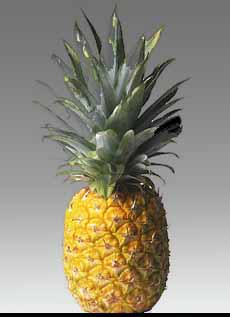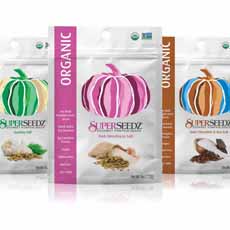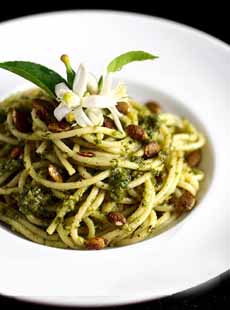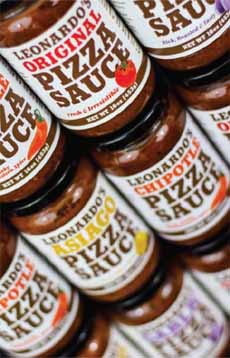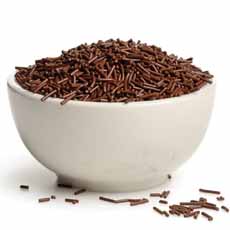|
Here’s what you get when you combine three salad concepts:
Cobb Salad
Wedge Salad
Salade Lyonnaise
It’s a Wainer Salad (photo #4). Created by the creative folks at Sid Wainer, a gourmet produce distributor, it demonstrates how you can combine favorite ingredients from different dishes to create something new.
Sure, people have been substituting lobster for the chicken to make a Lobster Cobb Salad; but how about substituting romaine or frisée for the iceberg lettuce?
We have a list below of salads for your mashup; but first, the Wainter:
All three of these salads have been popular for decades—even centuries. Two are American creations, one is French.
COBB SALAD
Cobb Salad (photo #2)was created in 1937 at the Brown Derby restaurant in Hollywood: an on-the-fly assembly of whatever was in the kitchen one late night.
Owner Bob Cobb was scrounging in the kitchen’s refrigerator for a snack for himself and Sid Grauman, proprietor of Grauman’s Chinese Theatre. He compiled a plate of romaine lettuce, tomatoes, cold breast of chicken, hard-boiled egg, chives, blue cheese, bacon and some watercress.
The original French dressing used was synonymous at the time with vinaigrette—the standard salad dressing of France.
Over time, a sweet, decidedly non-French, orange-colored vinaigrette (from ketchup, not a very French condiment) appeared in the U.S. and Canada. It’s what “French dressing” is today. To make it, combine 1/4 cup white wine vinegar, 1/3 cup olive oil, 1/4 cup ketchup, 1 tablespoon sugar, 2 teaspoons paprika, 1 teaspoon Worcestershire sauce, a pinch of salt. Our mother halved the sugar and threw in a clove of garlic.
But we prefer the original vinaigrette, or even better, a chunky blue cheese dressing.
The salad created on that long-ago evening was so delicious, that Sid Grauman came back the next day and asked for a “Cobb Salad.” It went onto the menu, and never left. (The restaurant was destroyed by fire in 1987.)
Here’s more of the history of Cobb Salad.
SALADE LYONNAISE
Cooked eggs on salads have long been part of French cuisine. The most noteworthy:
Salade Niçoise, from the city of Nice on the French Riviera. The salad began to evolve in the late 19th century using ingredients accessible to the poor, including hard-boiled eggs. The recipe evolved to include additional ingredients, from steamed green beans to anchovies and tomatoes. Here’s a recipe.
Salade Lyonnaise (photo #1) a, classic French country with roots in the area around Lyons, France. It has a poached egg on top, plus lardons (a salad version of bacon and eggs). In the U.S., a simpler version without the egg it is often called Frisée Salad. Here’s a recipe for Salade Lyonnaise.
Salade Lyonnaise was popularized in the U.S. in the early 1980s at The Odeon, a bistro in Manhattan’s TriBeCa neighborhood.
WEDGE SALAD
Wedge Salad (photo #3) began to emerge in the 1950s, when restaurants offered hearts of iceberg lettuce salad with creamy dressings. The head was cut into quarters and plated with a slice of tomato for color.
Homemakers were fans, too, because iceberg heads were sold fully trimmed, with little waste, and had a longer shelf life in the fridge. It was easy to cut into wedges or slice into shreds. The lettuce’s crunch was very popular, if bland-tasting (solution: lots of dressing—like creamy blue cheese).
Thanks to the retro food movement of the past decade, iceberg has returned to restaurant menus beyond its steakhouse stronghold, and the hearts of lettuce salad are now known by a trendier name: wedge salad. Bacon was added, because bacon has become a garnishs of choice.
By the way, iceberg lettuce was a mutation, discovered in the late 1800s. Here’s the history of iceberg lettuce, and more about wedge salads.
WHAT’S YOUR SALAD MASHUP?
|
|

[1] Parent #1: Salade Lyonnaise, a French frisée salad with lardons (here’s a recipe from Saveur).
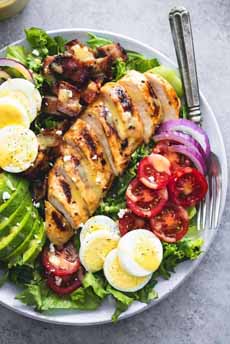
[2] Parent #2, a Cobb Salad, invented at the Brown Derby restaurant in Hollywood (here’s the recipe from La Creme De La Crumb).

[3] Parent #3: Wedge Salad (here’s a recipe from Little Broken).

[4] The Sid Wainer fusion: a slice (not wedge) of iceberg lettuce with blue cheese dressing and bacon from the Wedge Salad, cubed chicken from the Cobb Salad and a poached egg from Salade Lyonnaise.
|
In addition to the three salads above, here are 10 more popular green salads with ingredients you can pick and choice to make a [Your Name Here] Salad.
Arugula Salad: arugula, cherry tomatoes, pine nuts, olive oil vinaigrette with fresh lemon juice, parmesan cheese
Avocado Salad: avocado, cucumber, tomato, red onion, cilantro
Caesar Salad: romaine, anchovies, croutons, grated parmesan cheese
Endive Salad: endive, blue cheese, pear, walnuts, balsamic vinaigrette
Greek Salad: feta, bell peppers, peperoncini, red onion, kalamata olives, tomato, oregano, lemon juice, oil and vinegar, optional stuffed grape leaves
Kale Salad kale, chopped almonds, apple, parmesan cheese
Mesclun Salad: mixed baby lettuces, walnut oil or hazelnut oil vinaigrette, goat cheese
Mixed Green Salad: lettuce with bell pepper, carrot, celery, onion, tomato
Spinach Salad: baby spinach, bacon, feta, strawberries
Watercress Salad: watercress, onion, dijon vinaigrette
|






